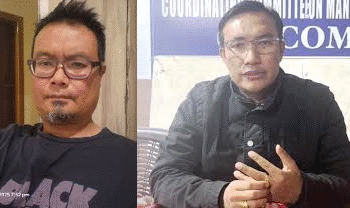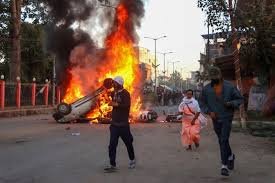From ICU executions to daily shootouts, Bihar’s law and order crisis has sparked political uproar. Is this the final blow for a fading Nitish Kumar?
BY Nain Upadhyay
July 17, 2025 —For over three decades, the BJP’s politics in Bihar has revolved around vilifying the Lalu Prasad-led RJD as the embodiment of “Jungle Raj”—a time between 1990 and 2004 when markets and shops shut by evening, life felt dangerously fleeting, kidnappings thrived, businessmen fled the state, and shootouts became routine.
Today, that spectre has returned. And make no mistake—Part II of this ‘Jungle Raj’ is far grimmer, more chilling, and more spectral than before.
A blistering wave of violent crime has swept through Bihar, reigniting public fear and political fury. In just the past two weeks, the state has witnessed a string of bold, daylight killings—including a murder inside a hospital ICU. These chilling events have left citizens shaken and leaders groping for explanations.
The most chilling incident occurred on July 67, when five masked gunmen walked into Paras HMRI Hospital in Patna’s Raja Bazaar, entered an ICU, and executed Chandan Mishra—a life-convict on medical parole. Security camera footage shows the assassins calmly line up, take shots at close range, and walk out—highlighting a gaping breakdown in institutional safeguards.
READ: Army Jawan Arrested in Uri for Spying for Pakistan’s ISI
Barely did the news settle than the Leader of Opposition Tejashwi Prasad Yadav (RJD) unleashed a devastating critique of the state government: “There is complete lawlessness. It’s a reign of criminals. No one is safe in Bihar.” Tejashwi recalled earlier instances of gunfire near his own residence, declaring: “Law and order has turned into a crime system… CM is mute, even as rounds are fired a kilometer from his house.
पुलिस का इकबाल “क्षय”, अधिकारी बने “रंक”
गुंडे बने “विजय” व अपराधी बने “सम्राट”
अस्पताल में घुसकर बेख़ौफ़ अपराधियों में गोली मारी। कल प्रधानमंत्री इसी जंगलराज पर प्रवचन देने बिहार आ रहे है। #Crime #Bihar #india pic.twitter.com/BDProZcPrw
— Tejashwi Yadav (@yadavtejashwi) July 17, 2025
Joining the chorus, Union Minister Chirag Paswan (LJP)—an NDA ally—warned the administration that criminal morale is sky‑high, insisting that daily murders reflect a system unable to protect citizens. He lambasted police inefficiency: “The functioning of the police and administration is beyond comprehension.”
Facing the heat over collapsing law and order situation, Additional Director General of Police, Kundan Krishnan, said that that over two dozen killings occurred in the first thirteen days of July, and stressing that socio-economic issues—like youth unemployment and easy access to illegal firearms—are fueling the surge.
“There is a surge in crime in Bihar during the monsoon when farmers are idle,” he claimed—without explaining how exactly farmers are linked to organized crime in the state.
These political outcries echo familiar refrains from the 1990s, when Bihar earned its “Jungle Raj” tag—marked by rampant mafia activity, politicized crime, and impunity shielded by political patronage. Today’s critics worry that old networks, emboldened by the return of RJD to power in the ruling Mahagathbandhan, are reclaiming lost territory.
Despite official claims of swift arrests, public confidence remains low. A former IPS officer summarised the sentiment: “When police fear political backlash for doing their job, law enforcement weakens. Morale is low.” Meanwhile, Vijay Kumar Sinha, Deputy CM (BJP), blamed the rise on sand, land, and liquor mafias, alleging their links to RJD.
But one thing is clear: the rising crime graph in Bihar appears closely linked to Chief Minister Nitish Kumar’s deteriorating health. When Kumar was firmly in control, the state saw significant improvements in law and order. Criminals—barring those protected for political reasons—were largely forced to lie low. But now, as Kumar enters the twilight of his political career and speculation about his health intensifies, the administrative machinery seems to have collapsed. In the resulting vacuum, criminal elements have resurfaced with alarming boldness.
READ:Historic Verdict: SC Grants Equal Inheritance Rights to Tribal Women
Available data supports the narrative of deterioration. According to PTI–verified numbers, murder cases almost doubled in the first half of 2025—1,376 compared to 2,786 in all of 2024. Many cite proliferation of illegal firearms and open ammunition trade as key contributors.
Despite governmental claims of improved infrastructure and policing capacity, citizens say the reality on the ground is grim. In Patna’s Kankarbagh area, local teacher Ragini Sinha declared she avoids walking after dark, citing recurring snatchings and police negligence. In Gaya, shopkeeper Mohammad Faizan described his cousin’s grocery store being looted—with zero arrests despite police visits.
The political storm is growing as Bihar heads toward 2025 assembly elections. Analysts believe law-and‑order failure may become a decisive issue. BJP leaders in Delhi have signalled concern, keeping Bihar’s rising violence under watch ahead of Prime Minister Modi’s upcoming visit, during which projects worth ₹7,200 crore are slated for rollout.
Amid mounting pressure, Nitish Kumar insists that no criminal activity will go unchecked. A statement from his office declared: “The police are actively investigating all cases. No criminal will be spared, and the rule of law shall prevail.” Yet to many, these words ring hollow.
Once known for leading from the front, Nitish now seeks to reassure the public through press releases—messages that have few takers. The shift is stark. ‘Sushasan Babu,’ as he was once fondly called, no longer appears in control. Even his harshest critics admit: had Nitish Kumar been in good health, he would never have let law and order slide this far—even if it meant sacrificing his office.
One activist framed the larger context: Bihar’s history of caste-based violence, political criminalization, and weak institutions makes resurgence all too possible. “If the government doesn’t act now,” he warned, “the specter of ‘Jungle Raj 2.0’ could define the narrative of this election.”
The broader challenge is clear: Bihar must reconcile its developmental ambitions with urgent reforms in policing, justice delivery, and arms regulation. Experts call for fast-tracked investigations, community policing, and revamping legal frameworks to crack down on illegal firearms and political-criminal nexus.
As voters in towns and villages observe the government’s next moves, one thing is certain: the lingering memory of lawless years under Lalu—and the fresh injuries of July’s violence—will weigh heavily on Bihar’s political future.













